HRM Strategies & Learning Curve Analysis
VerifiedAdded on 2020/07/22
|18
|5384
|51
AI Summary
This assignment requires a critical evaluation of Purcell's 'Strategy and Human Resource Management' and Kolb's Learning Style theory. Students must analyze how corporate strategy impacts human resource management practices and apply Kolb's model to create an employee training program, including a learning curve analysis.
Contribute Materials
Your contribution can guide someone’s learning journey. Share your
documents today.
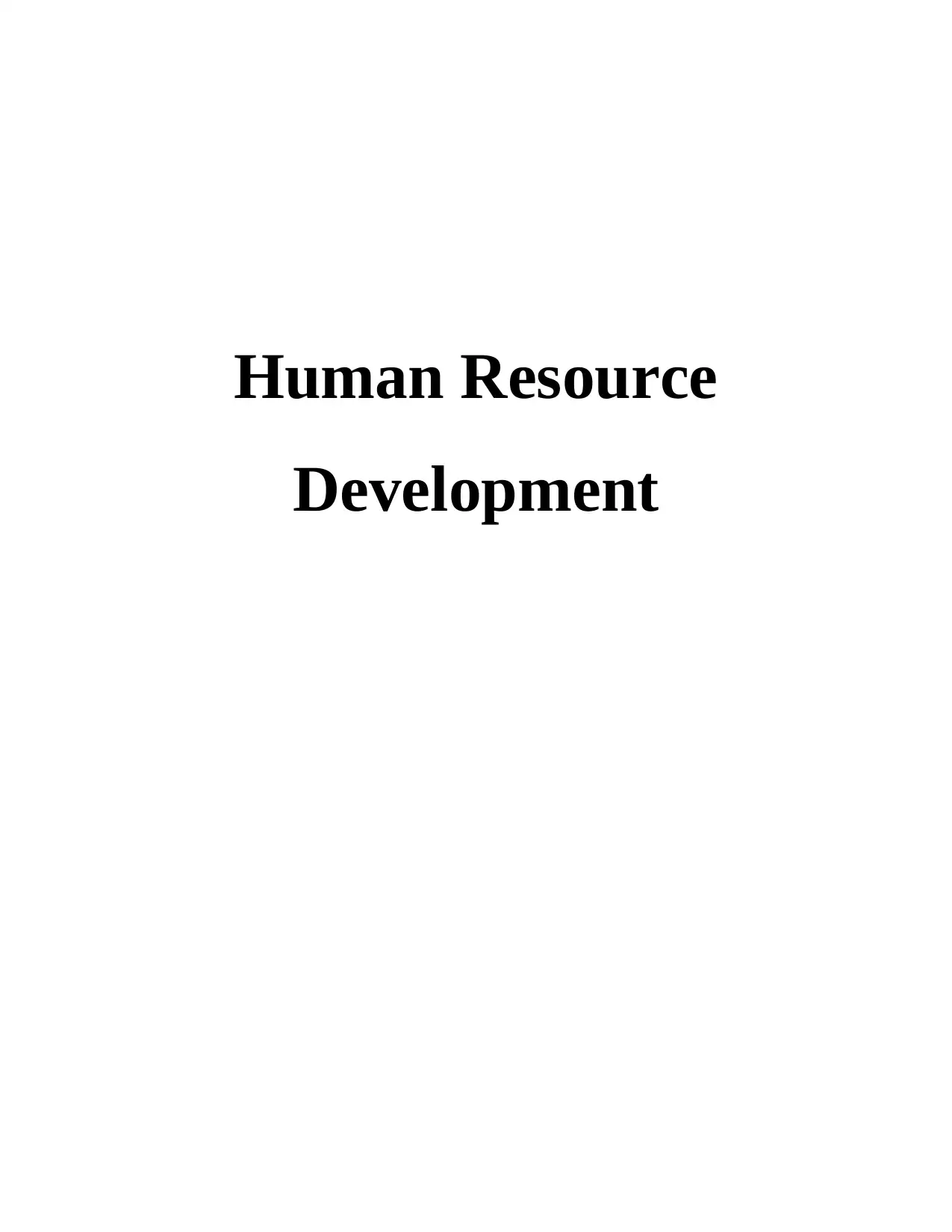
Human Resource
Development
Development
Secure Best Marks with AI Grader
Need help grading? Try our AI Grader for instant feedback on your assignments.
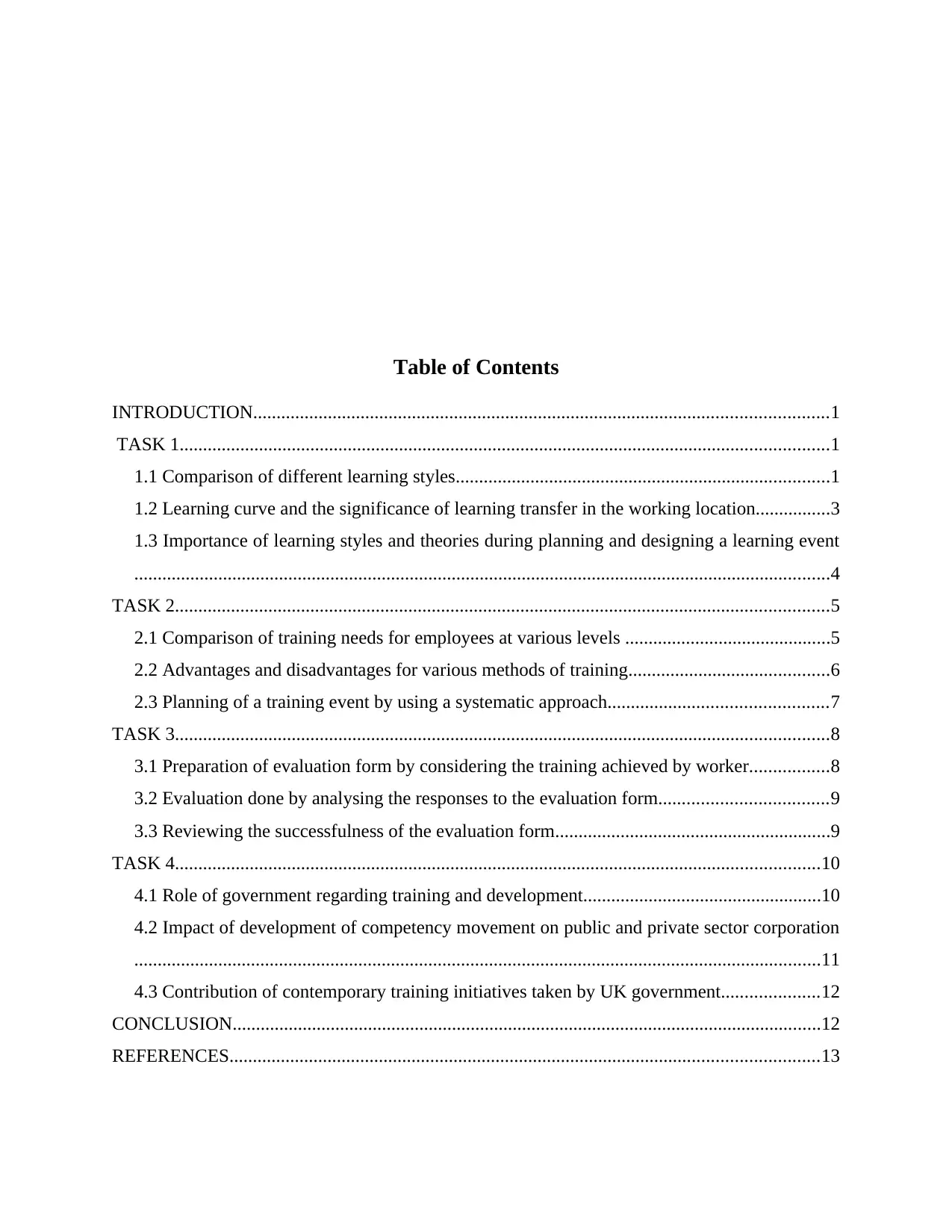
Table of Contents
INTRODUCTION...........................................................................................................................1
TASK 1...........................................................................................................................................1
1.1 Comparison of different learning styles................................................................................1
1.2 Learning curve and the significance of learning transfer in the working location................3
1.3 Importance of learning styles and theories during planning and designing a learning event
.....................................................................................................................................................4
TASK 2............................................................................................................................................5
2.1 Comparison of training needs for employees at various levels ............................................5
2.2 Advantages and disadvantages for various methods of training...........................................6
2.3 Planning of a training event by using a systematic approach...............................................7
TASK 3............................................................................................................................................8
3.1 Preparation of evaluation form by considering the training achieved by worker.................8
3.2 Evaluation done by analysing the responses to the evaluation form....................................9
3.3 Reviewing the successfulness of the evaluation form...........................................................9
TASK 4..........................................................................................................................................10
4.1 Role of government regarding training and development...................................................10
4.2 Impact of development of competency movement on public and private sector corporation
...................................................................................................................................................11
4.3 Contribution of contemporary training initiatives taken by UK government.....................12
CONCLUSION..............................................................................................................................12
REFERENCES..............................................................................................................................13
INTRODUCTION...........................................................................................................................1
TASK 1...........................................................................................................................................1
1.1 Comparison of different learning styles................................................................................1
1.2 Learning curve and the significance of learning transfer in the working location................3
1.3 Importance of learning styles and theories during planning and designing a learning event
.....................................................................................................................................................4
TASK 2............................................................................................................................................5
2.1 Comparison of training needs for employees at various levels ............................................5
2.2 Advantages and disadvantages for various methods of training...........................................6
2.3 Planning of a training event by using a systematic approach...............................................7
TASK 3............................................................................................................................................8
3.1 Preparation of evaluation form by considering the training achieved by worker.................8
3.2 Evaluation done by analysing the responses to the evaluation form....................................9
3.3 Reviewing the successfulness of the evaluation form...........................................................9
TASK 4..........................................................................................................................................10
4.1 Role of government regarding training and development...................................................10
4.2 Impact of development of competency movement on public and private sector corporation
...................................................................................................................................................11
4.3 Contribution of contemporary training initiatives taken by UK government.....................12
CONCLUSION..............................................................................................................................12
REFERENCES..............................................................................................................................13

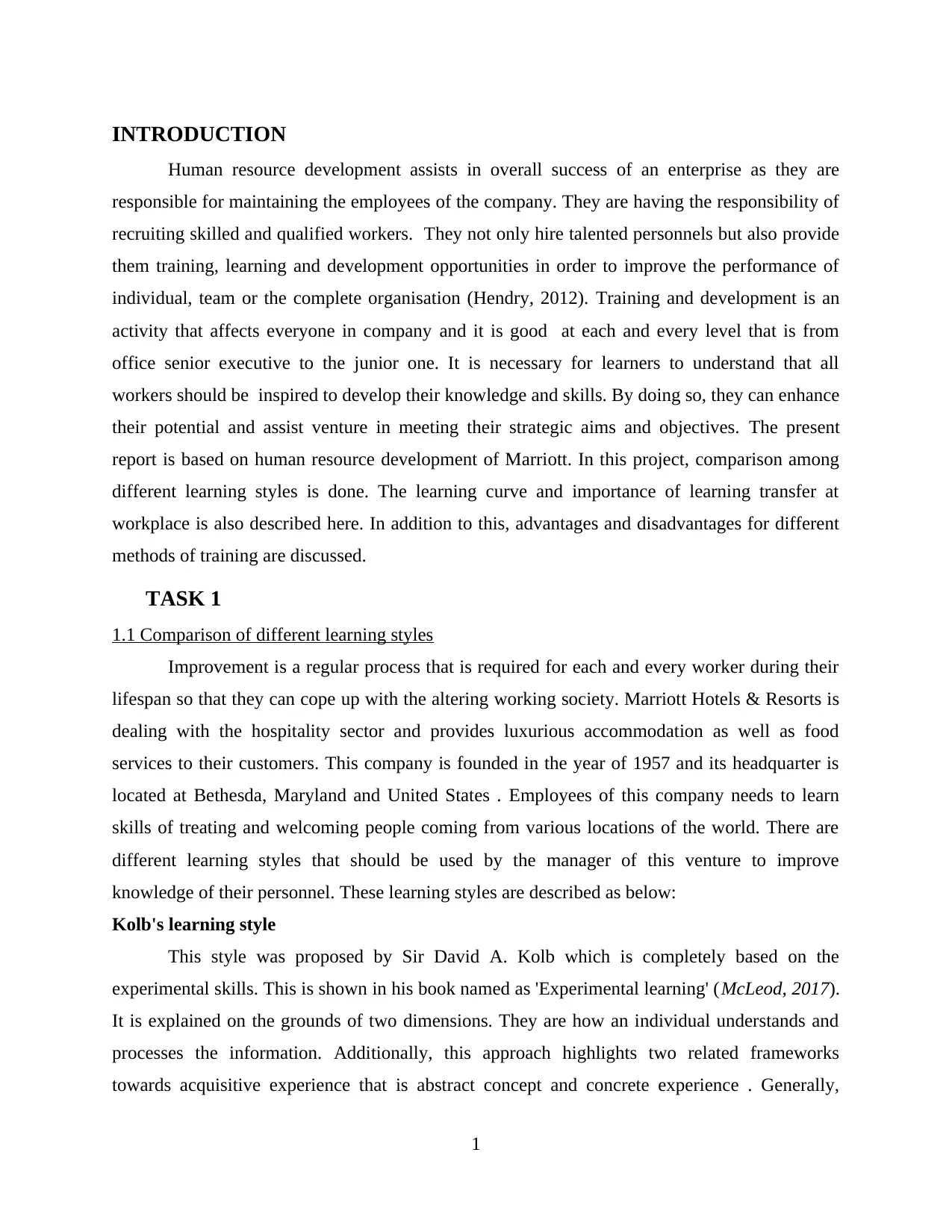
INTRODUCTION
Human resource development assists in overall success of an enterprise as they are
responsible for maintaining the employees of the company. They are having the responsibility of
recruiting skilled and qualified workers. They not only hire talented personnels but also provide
them training, learning and development opportunities in order to improve the performance of
individual, team or the complete organisation (Hendry, 2012). Training and development is an
activity that affects everyone in company and it is good at each and every level that is from
office senior executive to the junior one. It is necessary for learners to understand that all
workers should be inspired to develop their knowledge and skills. By doing so, they can enhance
their potential and assist venture in meeting their strategic aims and objectives. The present
report is based on human resource development of Marriott. In this project, comparison among
different learning styles is done. The learning curve and importance of learning transfer at
workplace is also described here. In addition to this, advantages and disadvantages for different
methods of training are discussed.
TASK 1
1.1 Comparison of different learning styles
Improvement is a regular process that is required for each and every worker during their
lifespan so that they can cope up with the altering working society. Marriott Hotels & Resorts is
dealing with the hospitality sector and provides luxurious accommodation as well as food
services to their customers. This company is founded in the year of 1957 and its headquarter is
located at Bethesda, Maryland and United States . Employees of this company needs to learn
skills of treating and welcoming people coming from various locations of the world. There are
different learning styles that should be used by the manager of this venture to improve
knowledge of their personnel. These learning styles are described as below:
Kolb's learning style
This style was proposed by Sir David A. Kolb which is completely based on the
experimental skills. This is shown in his book named as 'Experimental learning' (McLeod, 2017).
It is explained on the grounds of two dimensions. They are how an individual understands and
processes the information. Additionally, this approach highlights two related frameworks
towards acquisitive experience that is abstract concept and concrete experience . Generally,
1
Human resource development assists in overall success of an enterprise as they are
responsible for maintaining the employees of the company. They are having the responsibility of
recruiting skilled and qualified workers. They not only hire talented personnels but also provide
them training, learning and development opportunities in order to improve the performance of
individual, team or the complete organisation (Hendry, 2012). Training and development is an
activity that affects everyone in company and it is good at each and every level that is from
office senior executive to the junior one. It is necessary for learners to understand that all
workers should be inspired to develop their knowledge and skills. By doing so, they can enhance
their potential and assist venture in meeting their strategic aims and objectives. The present
report is based on human resource development of Marriott. In this project, comparison among
different learning styles is done. The learning curve and importance of learning transfer at
workplace is also described here. In addition to this, advantages and disadvantages for different
methods of training are discussed.
TASK 1
1.1 Comparison of different learning styles
Improvement is a regular process that is required for each and every worker during their
lifespan so that they can cope up with the altering working society. Marriott Hotels & Resorts is
dealing with the hospitality sector and provides luxurious accommodation as well as food
services to their customers. This company is founded in the year of 1957 and its headquarter is
located at Bethesda, Maryland and United States . Employees of this company needs to learn
skills of treating and welcoming people coming from various locations of the world. There are
different learning styles that should be used by the manager of this venture to improve
knowledge of their personnel. These learning styles are described as below:
Kolb's learning style
This style was proposed by Sir David A. Kolb which is completely based on the
experimental skills. This is shown in his book named as 'Experimental learning' (McLeod, 2017).
It is explained on the grounds of two dimensions. They are how an individual understands and
processes the information. Additionally, this approach highlights two related frameworks
towards acquisitive experience that is abstract concept and concrete experience . Generally,
1
Secure Best Marks with AI Grader
Need help grading? Try our AI Grader for instant feedback on your assignments.
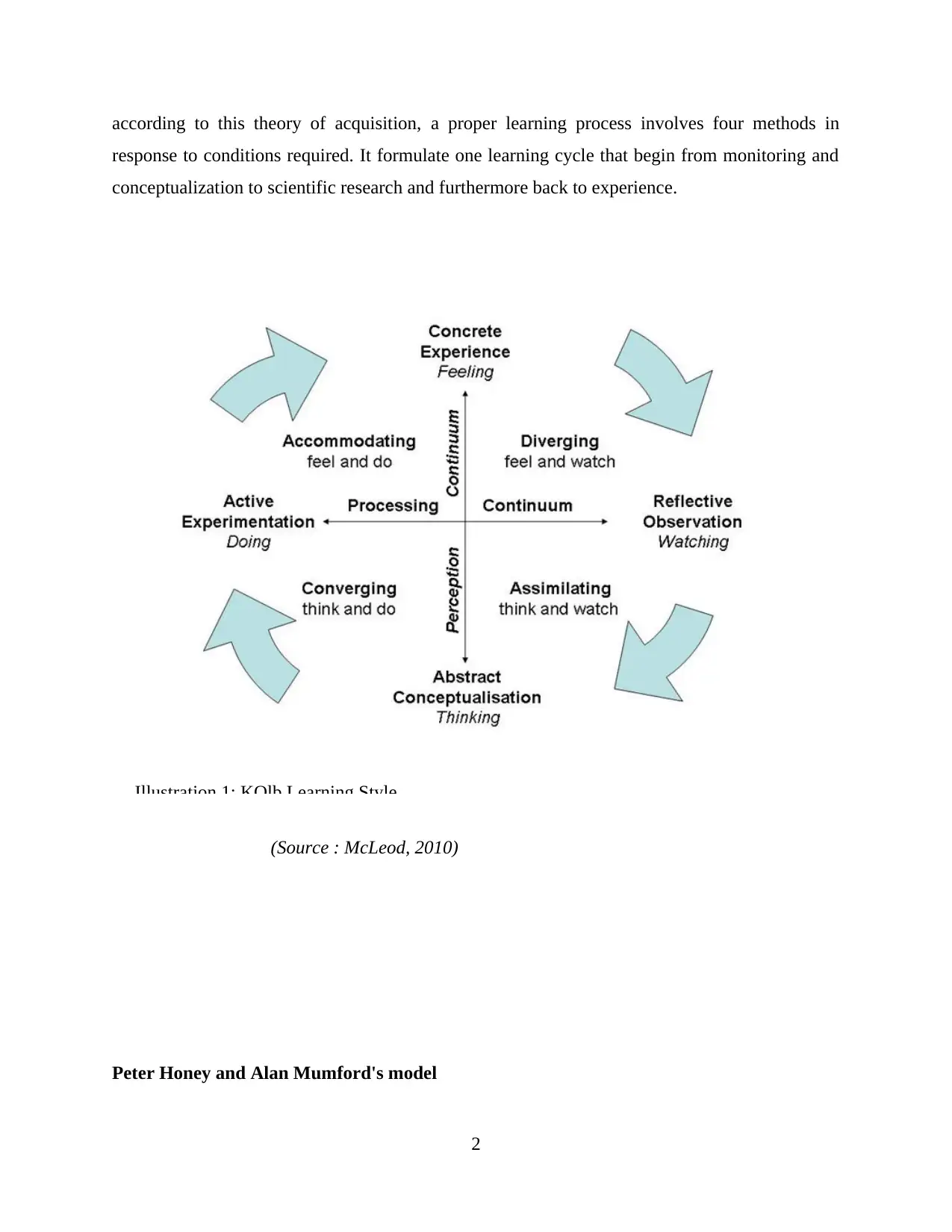
according to this theory of acquisition, a proper learning process involves four methods in
response to conditions required. It formulate one learning cycle that begin from monitoring and
conceptualization to scientific research and furthermore back to experience.
(Source : McLeod, 2010)
Peter Honey and Alan Mumford's model
2
Illustration 1: KOlb Learning Style
response to conditions required. It formulate one learning cycle that begin from monitoring and
conceptualization to scientific research and furthermore back to experience.
(Source : McLeod, 2010)
Peter Honey and Alan Mumford's model
2
Illustration 1: KOlb Learning Style

After inspiring from Kolb's learning-style, Peter Honey and Alan Mumford had found
this model in the year 1986. As per this model, workers select their modes of learning by
determining an appropriate way. There are four methods of this approach that are listed as below:
Activists: As per this mode, one can gain knowledge by performing several learning
activities such as group discussion, participating in competitions, brainstorming, solving
puzzles, etc.
Theorists: Learners who follow this mode have to go through various ideas or models of
scholars, scientist, truths etc. that has been written by some theorist.
Pragmatist: Such type of people learn things by applying the historical stories or case
studies of recent time.
Reflectors: People learn here from observing things or activities that are happening or
occurring in the world.
Therefore, there are various types of learning styles present that can be used by the staff
members of Marriott in order to improve their knowledge and skills.
1.2 Learning curve and the significance of learning transfer in the working location
Learning curve is the graphical representation of increment and decrement in acquisition
of a person and their participation in such activities. In fact, this curve assists in representing the
progress of a worker by considering their experience and effectual knowledge. This means that
learning curve has the capability to explain real situation of personnel with an aid of different
useful strategies and processes (Durden , 2017). It is playing a vital role in showing the
improvement of a staff. Therefore it can used by Marriott for taking instantaneous actions in
meeting the demands of their workers in terms of learning. In addition to this, it also highlights
the outcomes of the training and development activities that was conducted by the firm.
3
this model in the year 1986. As per this model, workers select their modes of learning by
determining an appropriate way. There are four methods of this approach that are listed as below:
Activists: As per this mode, one can gain knowledge by performing several learning
activities such as group discussion, participating in competitions, brainstorming, solving
puzzles, etc.
Theorists: Learners who follow this mode have to go through various ideas or models of
scholars, scientist, truths etc. that has been written by some theorist.
Pragmatist: Such type of people learn things by applying the historical stories or case
studies of recent time.
Reflectors: People learn here from observing things or activities that are happening or
occurring in the world.
Therefore, there are various types of learning styles present that can be used by the staff
members of Marriott in order to improve their knowledge and skills.
1.2 Learning curve and the significance of learning transfer in the working location
Learning curve is the graphical representation of increment and decrement in acquisition
of a person and their participation in such activities. In fact, this curve assists in representing the
progress of a worker by considering their experience and effectual knowledge. This means that
learning curve has the capability to explain real situation of personnel with an aid of different
useful strategies and processes (Durden , 2017). It is playing a vital role in showing the
improvement of a staff. Therefore it can used by Marriott for taking instantaneous actions in
meeting the demands of their workers in terms of learning. In addition to this, it also highlights
the outcomes of the training and development activities that was conducted by the firm.
3
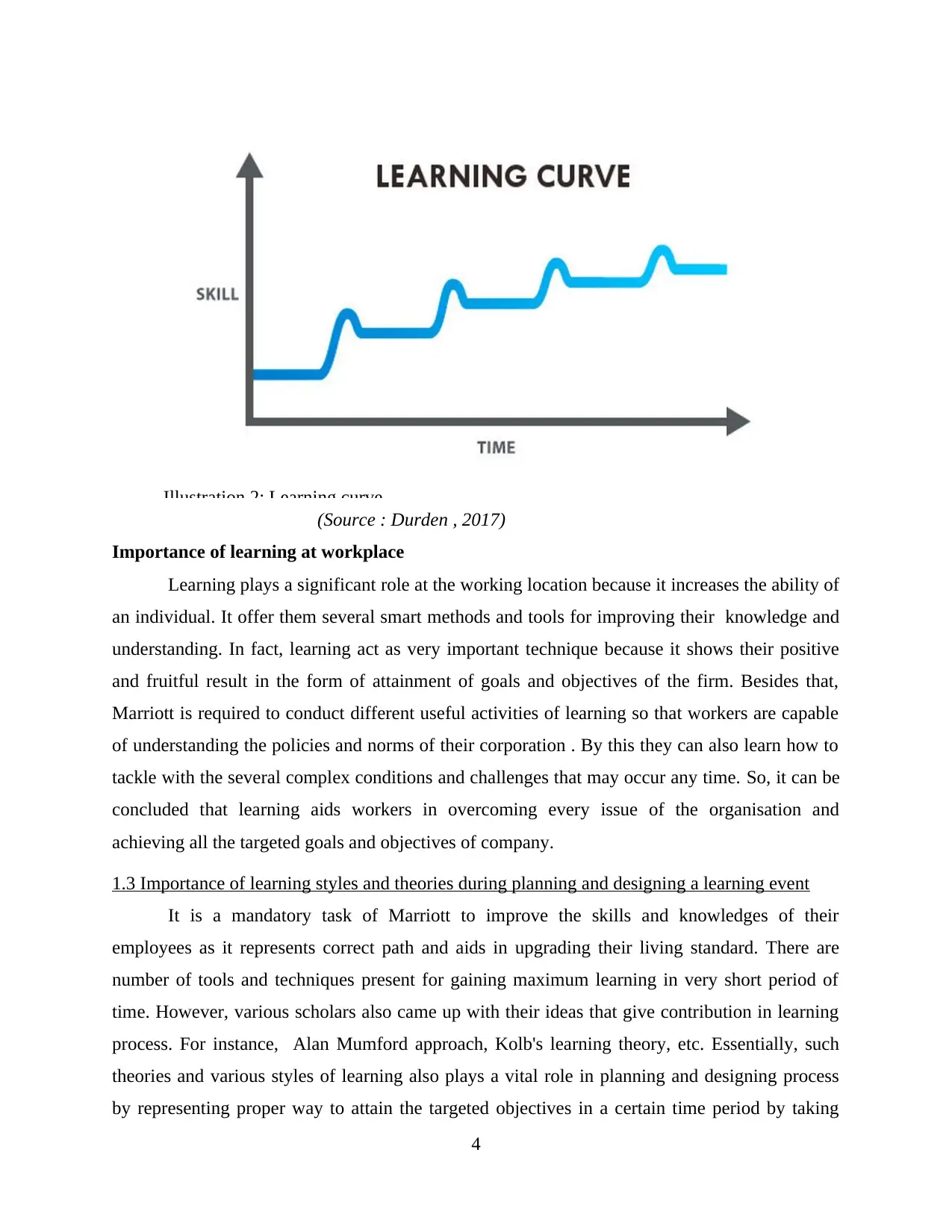
(Source : Durden , 2017)
Importance of learning at workplace
Learning plays a significant role at the working location because it increases the ability of
an individual. It offer them several smart methods and tools for improving their knowledge and
understanding. In fact, learning act as very important technique because it shows their positive
and fruitful result in the form of attainment of goals and objectives of the firm. Besides that,
Marriott is required to conduct different useful activities of learning so that workers are capable
of understanding the policies and norms of their corporation . By this they can also learn how to
tackle with the several complex conditions and challenges that may occur any time. So, it can be
concluded that learning aids workers in overcoming every issue of the organisation and
achieving all the targeted goals and objectives of company.
1.3 Importance of learning styles and theories during planning and designing a learning event
It is a mandatory task of Marriott to improve the skills and knowledges of their
employees as it represents correct path and aids in upgrading their living standard. There are
number of tools and techniques present for gaining maximum learning in very short period of
time. However, various scholars also came up with their ideas that give contribution in learning
process. For instance, Alan Mumford approach, Kolb's learning theory, etc. Essentially, such
theories and various styles of learning also plays a vital role in planning and designing process
by representing proper way to attain the targeted objectives in a certain time period by taking
4
Illustration 2: Learning curve
Importance of learning at workplace
Learning plays a significant role at the working location because it increases the ability of
an individual. It offer them several smart methods and tools for improving their knowledge and
understanding. In fact, learning act as very important technique because it shows their positive
and fruitful result in the form of attainment of goals and objectives of the firm. Besides that,
Marriott is required to conduct different useful activities of learning so that workers are capable
of understanding the policies and norms of their corporation . By this they can also learn how to
tackle with the several complex conditions and challenges that may occur any time. So, it can be
concluded that learning aids workers in overcoming every issue of the organisation and
achieving all the targeted goals and objectives of company.
1.3 Importance of learning styles and theories during planning and designing a learning event
It is a mandatory task of Marriott to improve the skills and knowledges of their
employees as it represents correct path and aids in upgrading their living standard. There are
number of tools and techniques present for gaining maximum learning in very short period of
time. However, various scholars also came up with their ideas that give contribution in learning
process. For instance, Alan Mumford approach, Kolb's learning theory, etc. Essentially, such
theories and various styles of learning also plays a vital role in planning and designing process
by representing proper way to attain the targeted objectives in a certain time period by taking
4
Illustration 2: Learning curve
Paraphrase This Document
Need a fresh take? Get an instant paraphrase of this document with our AI Paraphraser
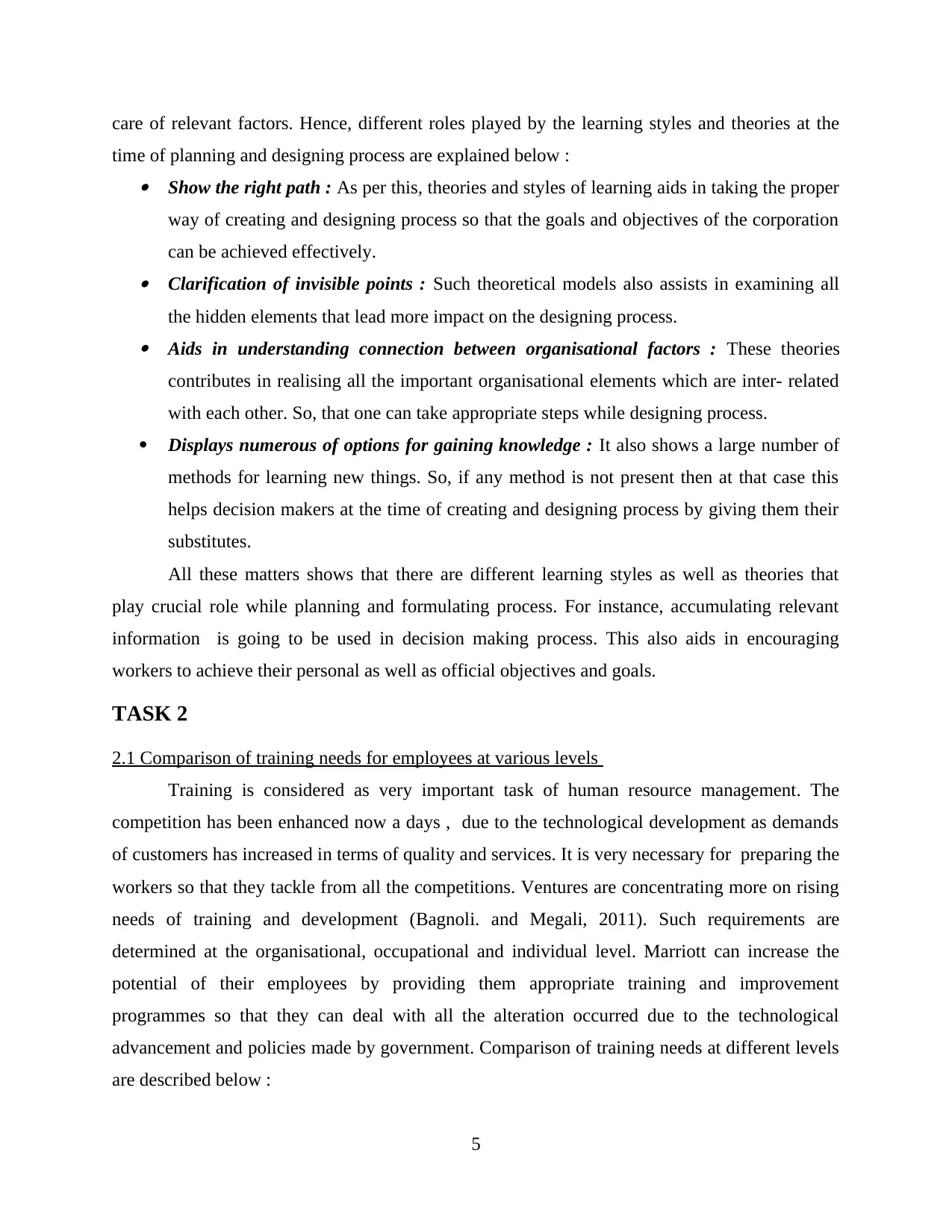
care of relevant factors. Hence, different roles played by the learning styles and theories at the
time of planning and designing process are explained below : Show the right path : As per this, theories and styles of learning aids in taking the proper
way of creating and designing process so that the goals and objectives of the corporation
can be achieved effectively. Clarification of invisible points : Such theoretical models also assists in examining all
the hidden elements that lead more impact on the designing process. Aids in understanding connection between organisational factors : These theories
contributes in realising all the important organisational elements which are inter- related
with each other. So, that one can take appropriate steps while designing process.
Displays numerous of options for gaining knowledge : It also shows a large number of
methods for learning new things. So, if any method is not present then at that case this
helps decision makers at the time of creating and designing process by giving them their
substitutes.
All these matters shows that there are different learning styles as well as theories that
play crucial role while planning and formulating process. For instance, accumulating relevant
information is going to be used in decision making process. This also aids in encouraging
workers to achieve their personal as well as official objectives and goals.
TASK 2
2.1 Comparison of training needs for employees at various levels
Training is considered as very important task of human resource management. The
competition has been enhanced now a days , due to the technological development as demands
of customers has increased in terms of quality and services. It is very necessary for preparing the
workers so that they tackle from all the competitions. Ventures are concentrating more on rising
needs of training and development (Bagnoli. and Megali, 2011). Such requirements are
determined at the organisational, occupational and individual level. Marriott can increase the
potential of their employees by providing them appropriate training and improvement
programmes so that they can deal with all the alteration occurred due to the technological
advancement and policies made by government. Comparison of training needs at different levels
are described below :
5
time of planning and designing process are explained below : Show the right path : As per this, theories and styles of learning aids in taking the proper
way of creating and designing process so that the goals and objectives of the corporation
can be achieved effectively. Clarification of invisible points : Such theoretical models also assists in examining all
the hidden elements that lead more impact on the designing process. Aids in understanding connection between organisational factors : These theories
contributes in realising all the important organisational elements which are inter- related
with each other. So, that one can take appropriate steps while designing process.
Displays numerous of options for gaining knowledge : It also shows a large number of
methods for learning new things. So, if any method is not present then at that case this
helps decision makers at the time of creating and designing process by giving them their
substitutes.
All these matters shows that there are different learning styles as well as theories that
play crucial role while planning and formulating process. For instance, accumulating relevant
information is going to be used in decision making process. This also aids in encouraging
workers to achieve their personal as well as official objectives and goals.
TASK 2
2.1 Comparison of training needs for employees at various levels
Training is considered as very important task of human resource management. The
competition has been enhanced now a days , due to the technological development as demands
of customers has increased in terms of quality and services. It is very necessary for preparing the
workers so that they tackle from all the competitions. Ventures are concentrating more on rising
needs of training and development (Bagnoli. and Megali, 2011). Such requirements are
determined at the organisational, occupational and individual level. Marriott can increase the
potential of their employees by providing them appropriate training and improvement
programmes so that they can deal with all the alteration occurred due to the technological
advancement and policies made by government. Comparison of training needs at different levels
are described below :
5

Organisational level : This involves determining the gaps between expected and the
actual performance of the workers. This requires the investigation of organisational
strategies and plans of company. So, there is a need of conduction of SWOT analysis
that is nothing but analysation of strengths, weaknesses, threats and opportunities of the
venture (Benabou and Tirole, 2011). The involvement of workers for performing their
job roles aids in increasing the efficiency of the firm. The training requires to be
provided at this level are given more concentration. It determines how workers are
trained so that organisational ambitions or target can be achieved. Business process level : This is the top most level of the company that has the motto to
set up aims and objectives of business. Employers who are going to do this also needs
some training as it is the most important task that requires to be done correctly without
any fault. In fact aims and objectives would decide all the other tasks of employees. So,
it have to be created very accurately. Process level : At this level , different processes gets prepared by the organisation that
deals with various situations. Workers are going to design it also needs proper training
and hint so that effective process gets prepared.
Activity level : Training also needed while performing any kind of activity so that they
get performed in an appropriate way. Activities likes games, arrangement of any cultural
event, etc. needs proper training.
2.2 Advantages and disadvantages for various methods of training
Training methods also have some advantages as well as disadvantages which play a
significant role in corporation in determining the use of training activities.
Advantages Disadvantages
Training programmes are very helpful in
improving the talent and knowledge of
workers.
On the other hand, workers feel stress - full or
nervous which demotivate them.
Training assists in process of decision making. As decision is taken by some of the employees
so some people get neglected at that time
(Bloom and Van Reenen,2011).
It follows proper planning and procedures for But at the same time, it is very time consuming
6
actual performance of the workers. This requires the investigation of organisational
strategies and plans of company. So, there is a need of conduction of SWOT analysis
that is nothing but analysation of strengths, weaknesses, threats and opportunities of the
venture (Benabou and Tirole, 2011). The involvement of workers for performing their
job roles aids in increasing the efficiency of the firm. The training requires to be
provided at this level are given more concentration. It determines how workers are
trained so that organisational ambitions or target can be achieved. Business process level : This is the top most level of the company that has the motto to
set up aims and objectives of business. Employers who are going to do this also needs
some training as it is the most important task that requires to be done correctly without
any fault. In fact aims and objectives would decide all the other tasks of employees. So,
it have to be created very accurately. Process level : At this level , different processes gets prepared by the organisation that
deals with various situations. Workers are going to design it also needs proper training
and hint so that effective process gets prepared.
Activity level : Training also needed while performing any kind of activity so that they
get performed in an appropriate way. Activities likes games, arrangement of any cultural
event, etc. needs proper training.
2.2 Advantages and disadvantages for various methods of training
Training methods also have some advantages as well as disadvantages which play a
significant role in corporation in determining the use of training activities.
Advantages Disadvantages
Training programmes are very helpful in
improving the talent and knowledge of
workers.
On the other hand, workers feel stress - full or
nervous which demotivate them.
Training assists in process of decision making. As decision is taken by some of the employees
so some people get neglected at that time
(Bloom and Van Reenen,2011).
It follows proper planning and procedures for But at the same time, it is very time consuming
6
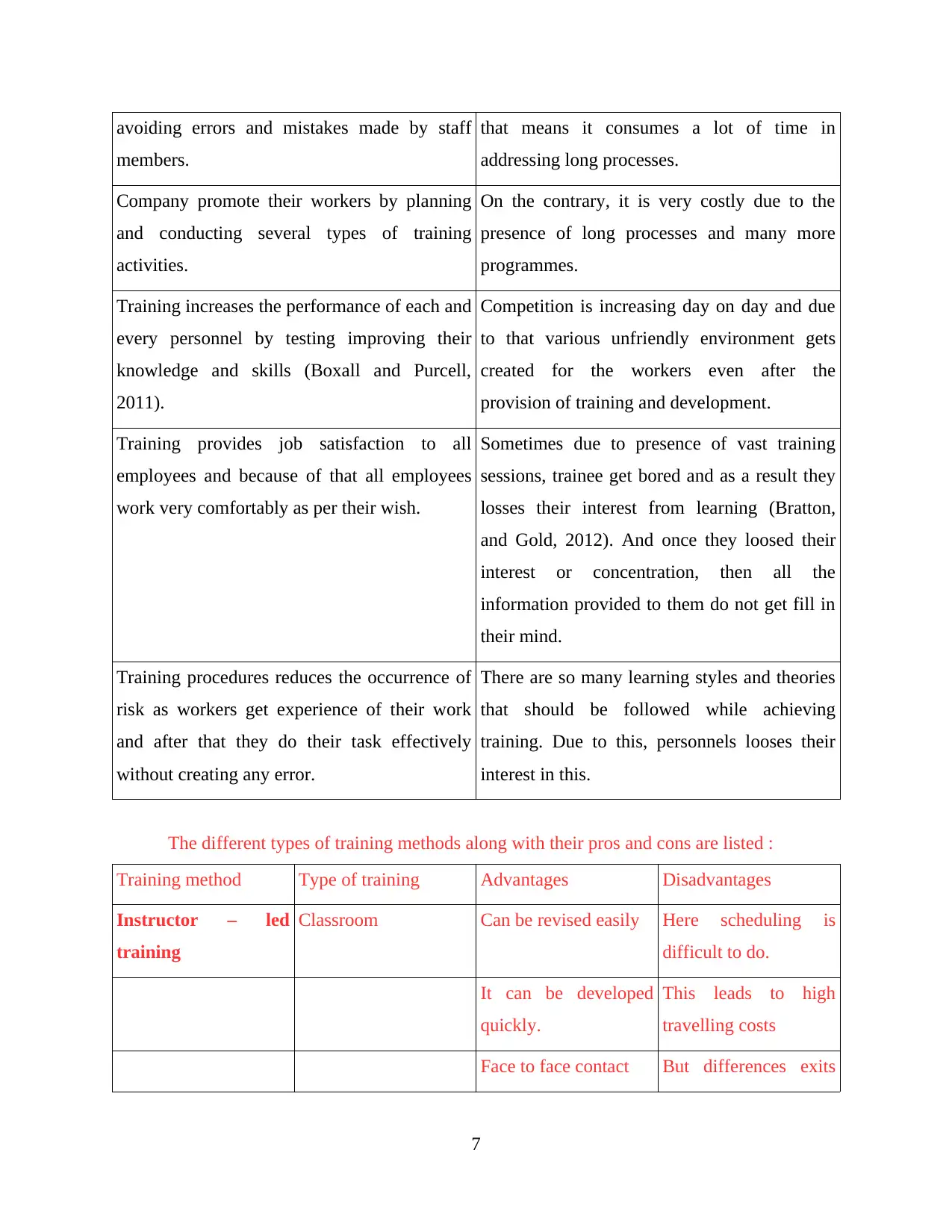
avoiding errors and mistakes made by staff
members.
that means it consumes a lot of time in
addressing long processes.
Company promote their workers by planning
and conducting several types of training
activities.
On the contrary, it is very costly due to the
presence of long processes and many more
programmes.
Training increases the performance of each and
every personnel by testing improving their
knowledge and skills (Boxall and Purcell,
2011).
Competition is increasing day on day and due
to that various unfriendly environment gets
created for the workers even after the
provision of training and development.
Training provides job satisfaction to all
employees and because of that all employees
work very comfortably as per their wish.
Sometimes due to presence of vast training
sessions, trainee get bored and as a result they
losses their interest from learning (Bratton,
and Gold, 2012). And once they loosed their
interest or concentration, then all the
information provided to them do not get fill in
their mind.
Training procedures reduces the occurrence of
risk as workers get experience of their work
and after that they do their task effectively
without creating any error.
There are so many learning styles and theories
that should be followed while achieving
training. Due to this, personnels looses their
interest in this.
The different types of training methods along with their pros and cons are listed :
Training method Type of training Advantages Disadvantages
Instructor – led
training
Classroom Can be revised easily Here scheduling is
difficult to do.
It can be developed
quickly.
This leads to high
travelling costs
Face to face contact But differences exits
7
members.
that means it consumes a lot of time in
addressing long processes.
Company promote their workers by planning
and conducting several types of training
activities.
On the contrary, it is very costly due to the
presence of long processes and many more
programmes.
Training increases the performance of each and
every personnel by testing improving their
knowledge and skills (Boxall and Purcell,
2011).
Competition is increasing day on day and due
to that various unfriendly environment gets
created for the workers even after the
provision of training and development.
Training provides job satisfaction to all
employees and because of that all employees
work very comfortably as per their wish.
Sometimes due to presence of vast training
sessions, trainee get bored and as a result they
losses their interest from learning (Bratton,
and Gold, 2012). And once they loosed their
interest or concentration, then all the
information provided to them do not get fill in
their mind.
Training procedures reduces the occurrence of
risk as workers get experience of their work
and after that they do their task effectively
without creating any error.
There are so many learning styles and theories
that should be followed while achieving
training. Due to this, personnels looses their
interest in this.
The different types of training methods along with their pros and cons are listed :
Training method Type of training Advantages Disadvantages
Instructor – led
training
Classroom Can be revised easily Here scheduling is
difficult to do.
It can be developed
quickly.
This leads to high
travelling costs
Face to face contact But differences exits
7
Secure Best Marks with AI Grader
Need help grading? Try our AI Grader for instant feedback on your assignments.
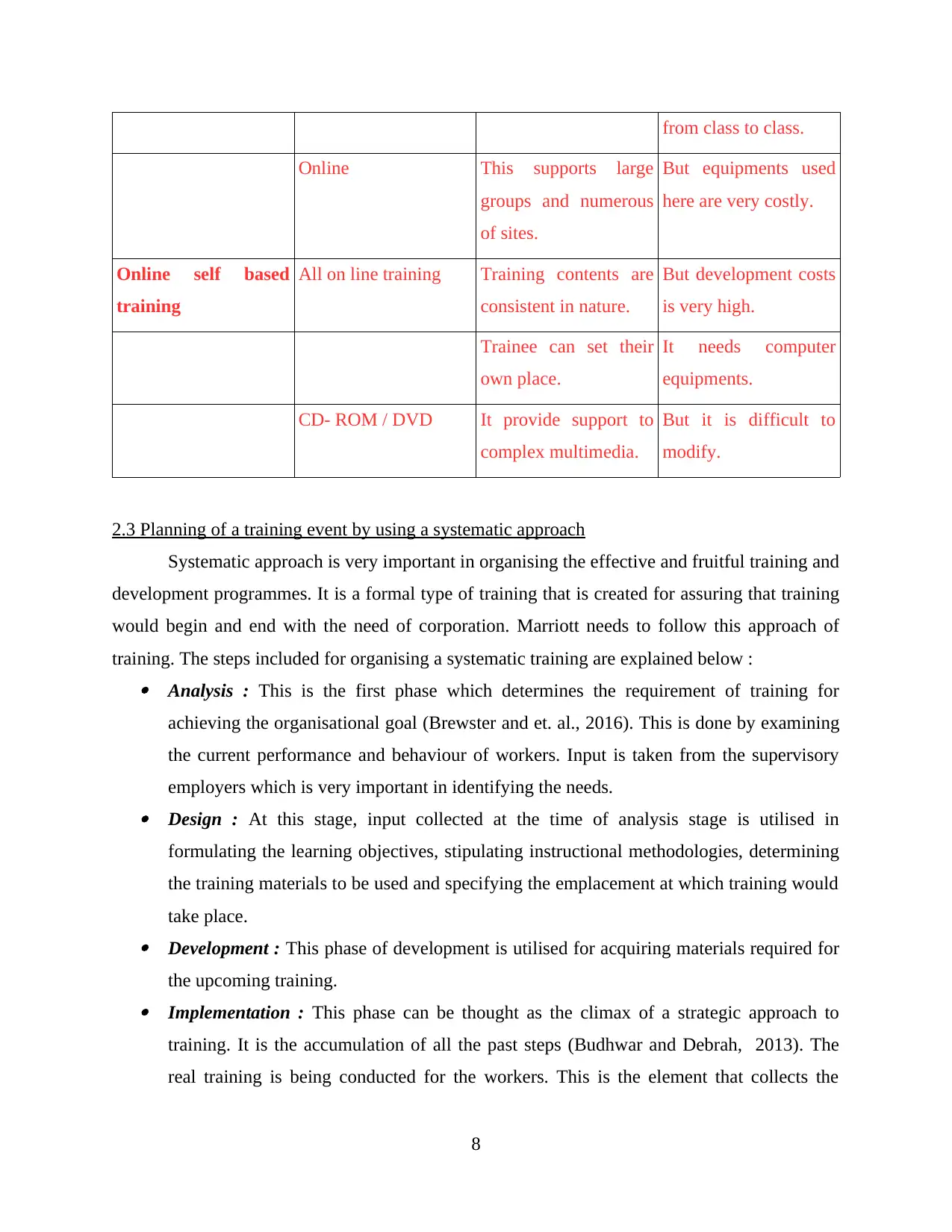
from class to class.
Online This supports large
groups and numerous
of sites.
But equipments used
here are very costly.
Online self based
training
All on line training Training contents are
consistent in nature.
But development costs
is very high.
Trainee can set their
own place.
It needs computer
equipments.
CD- ROM / DVD It provide support to
complex multimedia.
But it is difficult to
modify.
2.3 Planning of a training event by using a systematic approach
Systematic approach is very important in organising the effective and fruitful training and
development programmes. It is a formal type of training that is created for assuring that training
would begin and end with the need of corporation. Marriott needs to follow this approach of
training. The steps included for organising a systematic training are explained below : Analysis : This is the first phase which determines the requirement of training for
achieving the organisational goal (Brewster and et. al., 2016). This is done by examining
the current performance and behaviour of workers. Input is taken from the supervisory
employers which is very important in identifying the needs. Design : At this stage, input collected at the time of analysis stage is utilised in
formulating the learning objectives, stipulating instructional methodologies, determining
the training materials to be used and specifying the emplacement at which training would
take place. Development : This phase of development is utilised for acquiring materials required for
the upcoming training. Implementation : This phase can be thought as the climax of a strategic approach to
training. It is the accumulation of all the past steps (Budhwar and Debrah, 2013). The
real training is being conducted for the workers. This is the element that collects the
8
Online This supports large
groups and numerous
of sites.
But equipments used
here are very costly.
Online self based
training
All on line training Training contents are
consistent in nature.
But development costs
is very high.
Trainee can set their
own place.
It needs computer
equipments.
CD- ROM / DVD It provide support to
complex multimedia.
But it is difficult to
modify.
2.3 Planning of a training event by using a systematic approach
Systematic approach is very important in organising the effective and fruitful training and
development programmes. It is a formal type of training that is created for assuring that training
would begin and end with the need of corporation. Marriott needs to follow this approach of
training. The steps included for organising a systematic training are explained below : Analysis : This is the first phase which determines the requirement of training for
achieving the organisational goal (Brewster and et. al., 2016). This is done by examining
the current performance and behaviour of workers. Input is taken from the supervisory
employers which is very important in identifying the needs. Design : At this stage, input collected at the time of analysis stage is utilised in
formulating the learning objectives, stipulating instructional methodologies, determining
the training materials to be used and specifying the emplacement at which training would
take place. Development : This phase of development is utilised for acquiring materials required for
the upcoming training. Implementation : This phase can be thought as the climax of a strategic approach to
training. It is the accumulation of all the past steps (Budhwar and Debrah, 2013). The
real training is being conducted for the workers. This is the element that collects the
8
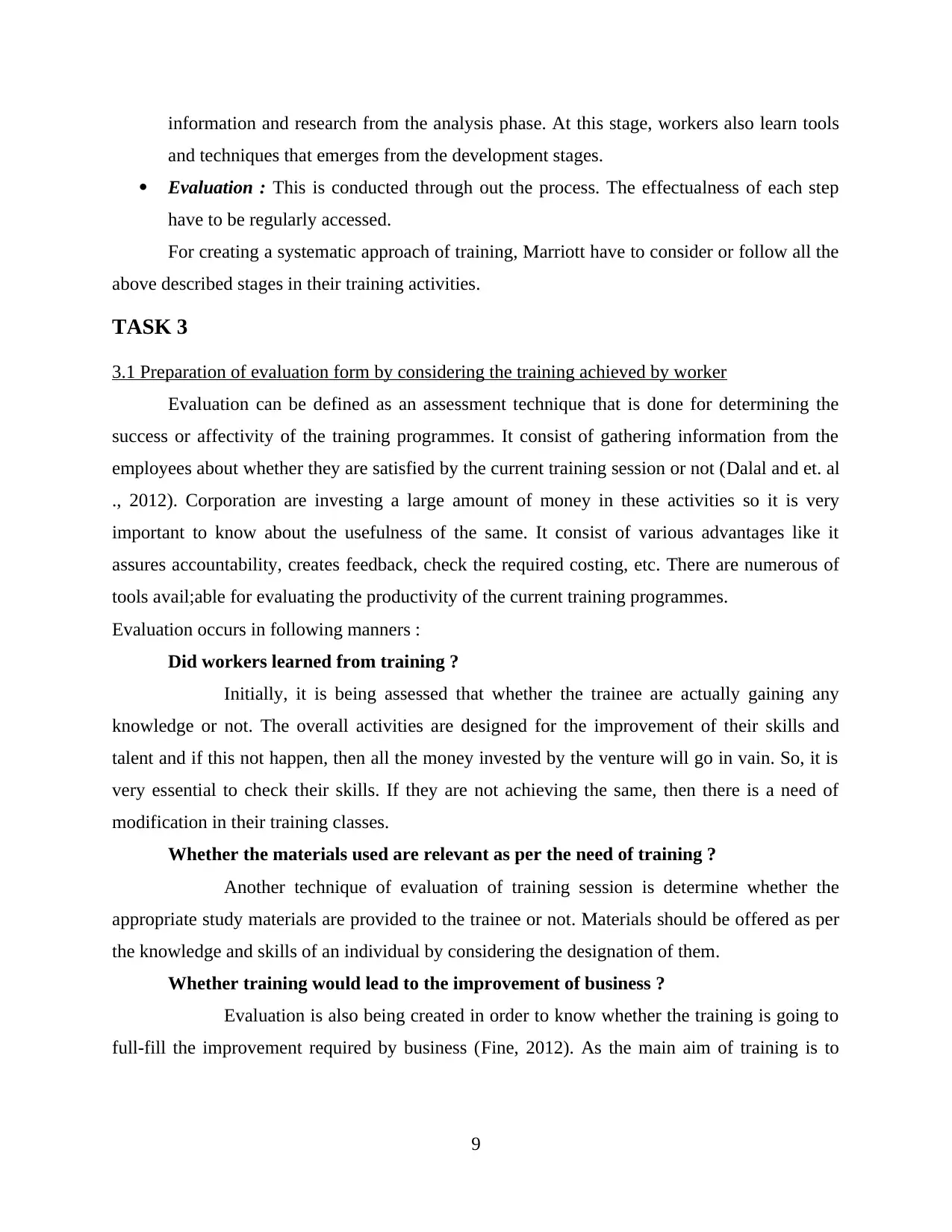
information and research from the analysis phase. At this stage, workers also learn tools
and techniques that emerges from the development stages.
Evaluation : This is conducted through out the process. The effectualness of each step
have to be regularly accessed.
For creating a systematic approach of training, Marriott have to consider or follow all the
above described stages in their training activities.
TASK 3
3.1 Preparation of evaluation form by considering the training achieved by worker
Evaluation can be defined as an assessment technique that is done for determining the
success or affectivity of the training programmes. It consist of gathering information from the
employees about whether they are satisfied by the current training session or not (Dalal and et. al
., 2012). Corporation are investing a large amount of money in these activities so it is very
important to know about the usefulness of the same. It consist of various advantages like it
assures accountability, creates feedback, check the required costing, etc. There are numerous of
tools avail;able for evaluating the productivity of the current training programmes.
Evaluation occurs in following manners :
Did workers learned from training ?
Initially, it is being assessed that whether the trainee are actually gaining any
knowledge or not. The overall activities are designed for the improvement of their skills and
talent and if this not happen, then all the money invested by the venture will go in vain. So, it is
very essential to check their skills. If they are not achieving the same, then there is a need of
modification in their training classes.
Whether the materials used are relevant as per the need of training ?
Another technique of evaluation of training session is determine whether the
appropriate study materials are provided to the trainee or not. Materials should be offered as per
the knowledge and skills of an individual by considering the designation of them.
Whether training would lead to the improvement of business ?
Evaluation is also being created in order to know whether the training is going to
full-fill the improvement required by business (Fine, 2012). As the main aim of training is to
9
and techniques that emerges from the development stages.
Evaluation : This is conducted through out the process. The effectualness of each step
have to be regularly accessed.
For creating a systematic approach of training, Marriott have to consider or follow all the
above described stages in their training activities.
TASK 3
3.1 Preparation of evaluation form by considering the training achieved by worker
Evaluation can be defined as an assessment technique that is done for determining the
success or affectivity of the training programmes. It consist of gathering information from the
employees about whether they are satisfied by the current training session or not (Dalal and et. al
., 2012). Corporation are investing a large amount of money in these activities so it is very
important to know about the usefulness of the same. It consist of various advantages like it
assures accountability, creates feedback, check the required costing, etc. There are numerous of
tools avail;able for evaluating the productivity of the current training programmes.
Evaluation occurs in following manners :
Did workers learned from training ?
Initially, it is being assessed that whether the trainee are actually gaining any
knowledge or not. The overall activities are designed for the improvement of their skills and
talent and if this not happen, then all the money invested by the venture will go in vain. So, it is
very essential to check their skills. If they are not achieving the same, then there is a need of
modification in their training classes.
Whether the materials used are relevant as per the need of training ?
Another technique of evaluation of training session is determine whether the
appropriate study materials are provided to the trainee or not. Materials should be offered as per
the knowledge and skills of an individual by considering the designation of them.
Whether training would lead to the improvement of business ?
Evaluation is also being created in order to know whether the training is going to
full-fill the improvement required by business (Fine, 2012). As the main aim of training is to
9
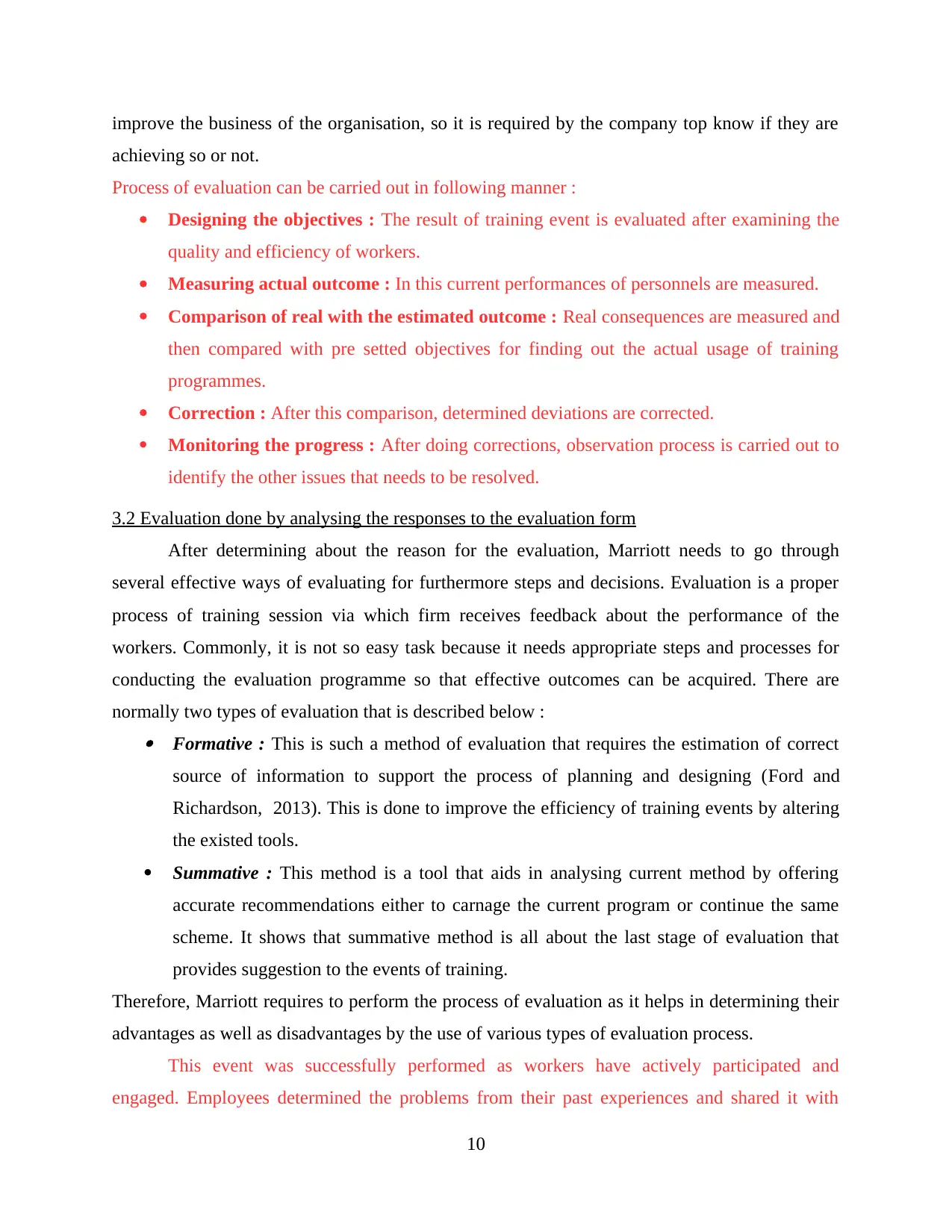
improve the business of the organisation, so it is required by the company top know if they are
achieving so or not.
Process of evaluation can be carried out in following manner :
Designing the objectives : The result of training event is evaluated after examining the
quality and efficiency of workers.
Measuring actual outcome : In this current performances of personnels are measured.
Comparison of real with the estimated outcome : Real consequences are measured and
then compared with pre setted objectives for finding out the actual usage of training
programmes.
Correction : After this comparison, determined deviations are corrected.
Monitoring the progress : After doing corrections, observation process is carried out to
identify the other issues that needs to be resolved.
3.2 Evaluation done by analysing the responses to the evaluation form
After determining about the reason for the evaluation, Marriott needs to go through
several effective ways of evaluating for furthermore steps and decisions. Evaluation is a proper
process of training session via which firm receives feedback about the performance of the
workers. Commonly, it is not so easy task because it needs appropriate steps and processes for
conducting the evaluation programme so that effective outcomes can be acquired. There are
normally two types of evaluation that is described below : Formative : This is such a method of evaluation that requires the estimation of correct
source of information to support the process of planning and designing (Ford and
Richardson, 2013). This is done to improve the efficiency of training events by altering
the existed tools.
Summative : This method is a tool that aids in analysing current method by offering
accurate recommendations either to carnage the current program or continue the same
scheme. It shows that summative method is all about the last stage of evaluation that
provides suggestion to the events of training.
Therefore, Marriott requires to perform the process of evaluation as it helps in determining their
advantages as well as disadvantages by the use of various types of evaluation process.
This event was successfully performed as workers have actively participated and
engaged. Employees determined the problems from their past experiences and shared it with
10
achieving so or not.
Process of evaluation can be carried out in following manner :
Designing the objectives : The result of training event is evaluated after examining the
quality and efficiency of workers.
Measuring actual outcome : In this current performances of personnels are measured.
Comparison of real with the estimated outcome : Real consequences are measured and
then compared with pre setted objectives for finding out the actual usage of training
programmes.
Correction : After this comparison, determined deviations are corrected.
Monitoring the progress : After doing corrections, observation process is carried out to
identify the other issues that needs to be resolved.
3.2 Evaluation done by analysing the responses to the evaluation form
After determining about the reason for the evaluation, Marriott needs to go through
several effective ways of evaluating for furthermore steps and decisions. Evaluation is a proper
process of training session via which firm receives feedback about the performance of the
workers. Commonly, it is not so easy task because it needs appropriate steps and processes for
conducting the evaluation programme so that effective outcomes can be acquired. There are
normally two types of evaluation that is described below : Formative : This is such a method of evaluation that requires the estimation of correct
source of information to support the process of planning and designing (Ford and
Richardson, 2013). This is done to improve the efficiency of training events by altering
the existed tools.
Summative : This method is a tool that aids in analysing current method by offering
accurate recommendations either to carnage the current program or continue the same
scheme. It shows that summative method is all about the last stage of evaluation that
provides suggestion to the events of training.
Therefore, Marriott requires to perform the process of evaluation as it helps in determining their
advantages as well as disadvantages by the use of various types of evaluation process.
This event was successfully performed as workers have actively participated and
engaged. Employees determined the problems from their past experiences and shared it with
10
Paraphrase This Document
Need a fresh take? Get an instant paraphrase of this document with our AI Paraphraser
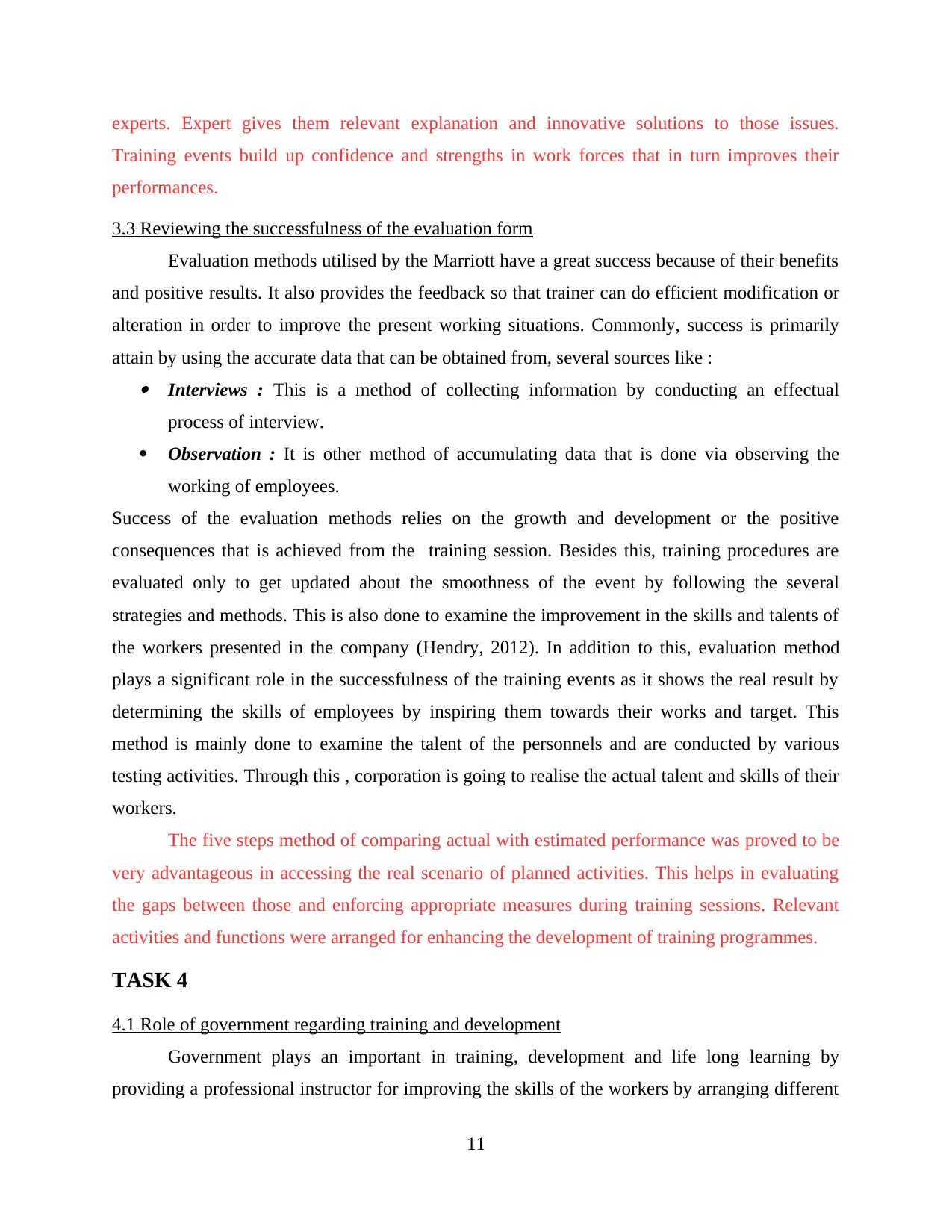
experts. Expert gives them relevant explanation and innovative solutions to those issues.
Training events build up confidence and strengths in work forces that in turn improves their
performances.
3.3 Reviewing the successfulness of the evaluation form
Evaluation methods utilised by the Marriott have a great success because of their benefits
and positive results. It also provides the feedback so that trainer can do efficient modification or
alteration in order to improve the present working situations. Commonly, success is primarily
attain by using the accurate data that can be obtained from, several sources like : Interviews : This is a method of collecting information by conducting an effectual
process of interview.
Observation : It is other method of accumulating data that is done via observing the
working of employees.
Success of the evaluation methods relies on the growth and development or the positive
consequences that is achieved from the training session. Besides this, training procedures are
evaluated only to get updated about the smoothness of the event by following the several
strategies and methods. This is also done to examine the improvement in the skills and talents of
the workers presented in the company (Hendry, 2012). In addition to this, evaluation method
plays a significant role in the successfulness of the training events as it shows the real result by
determining the skills of employees by inspiring them towards their works and target. This
method is mainly done to examine the talent of the personnels and are conducted by various
testing activities. Through this , corporation is going to realise the actual talent and skills of their
workers.
The five steps method of comparing actual with estimated performance was proved to be
very advantageous in accessing the real scenario of planned activities. This helps in evaluating
the gaps between those and enforcing appropriate measures during training sessions. Relevant
activities and functions were arranged for enhancing the development of training programmes.
TASK 4
4.1 Role of government regarding training and development
Government plays an important in training, development and life long learning by
providing a professional instructor for improving the skills of the workers by arranging different
11
Training events build up confidence and strengths in work forces that in turn improves their
performances.
3.3 Reviewing the successfulness of the evaluation form
Evaluation methods utilised by the Marriott have a great success because of their benefits
and positive results. It also provides the feedback so that trainer can do efficient modification or
alteration in order to improve the present working situations. Commonly, success is primarily
attain by using the accurate data that can be obtained from, several sources like : Interviews : This is a method of collecting information by conducting an effectual
process of interview.
Observation : It is other method of accumulating data that is done via observing the
working of employees.
Success of the evaluation methods relies on the growth and development or the positive
consequences that is achieved from the training session. Besides this, training procedures are
evaluated only to get updated about the smoothness of the event by following the several
strategies and methods. This is also done to examine the improvement in the skills and talents of
the workers presented in the company (Hendry, 2012). In addition to this, evaluation method
plays a significant role in the successfulness of the training events as it shows the real result by
determining the skills of employees by inspiring them towards their works and target. This
method is mainly done to examine the talent of the personnels and are conducted by various
testing activities. Through this , corporation is going to realise the actual talent and skills of their
workers.
The five steps method of comparing actual with estimated performance was proved to be
very advantageous in accessing the real scenario of planned activities. This helps in evaluating
the gaps between those and enforcing appropriate measures during training sessions. Relevant
activities and functions were arranged for enhancing the development of training programmes.
TASK 4
4.1 Role of government regarding training and development
Government plays an important in training, development and life long learning by
providing a professional instructor for improving the skills of the workers by arranging different
11
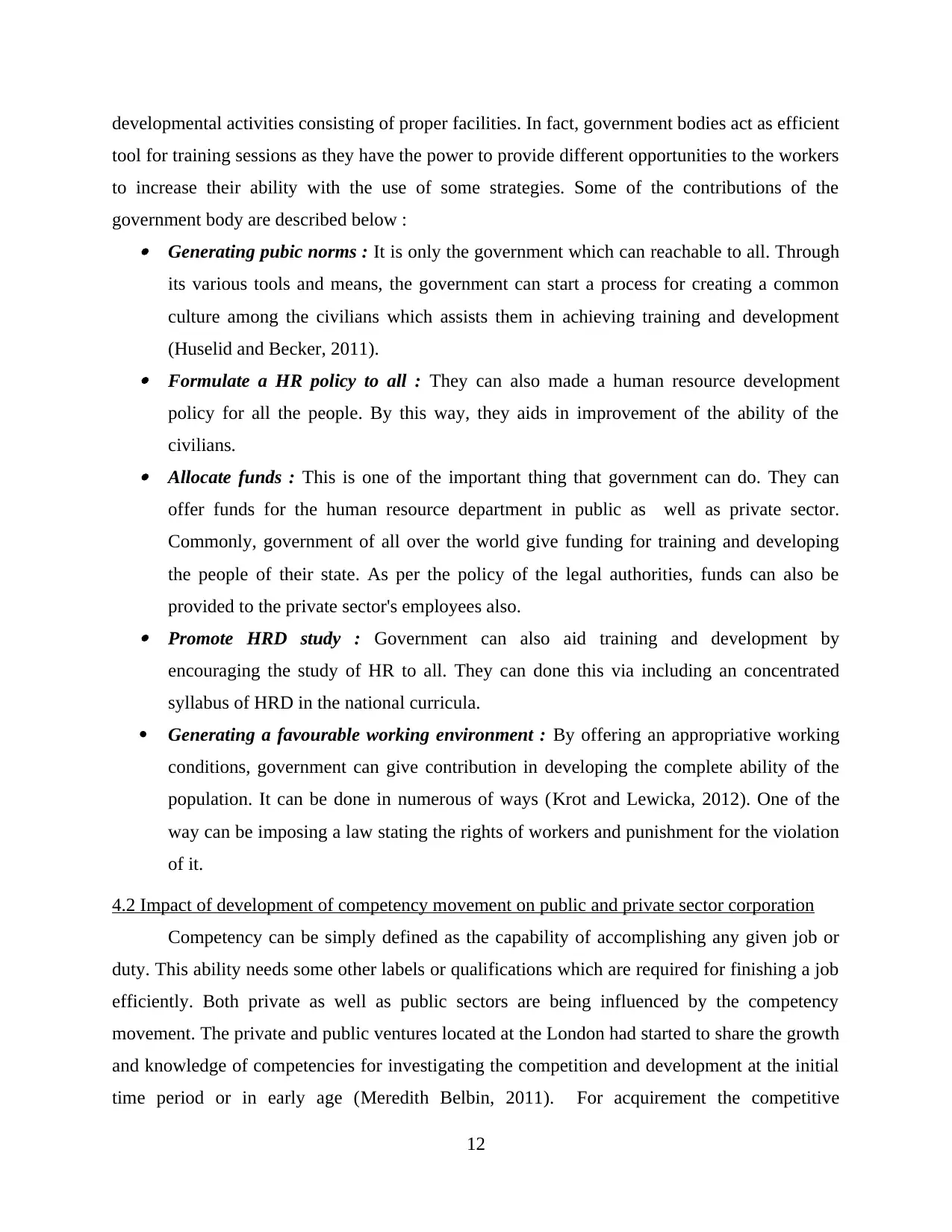
developmental activities consisting of proper facilities. In fact, government bodies act as efficient
tool for training sessions as they have the power to provide different opportunities to the workers
to increase their ability with the use of some strategies. Some of the contributions of the
government body are described below : Generating pubic norms : It is only the government which can reachable to all. Through
its various tools and means, the government can start a process for creating a common
culture among the civilians which assists them in achieving training and development
(Huselid and Becker, 2011). Formulate a HR policy to all : They can also made a human resource development
policy for all the people. By this way, they aids in improvement of the ability of the
civilians. Allocate funds : This is one of the important thing that government can do. They can
offer funds for the human resource department in public as well as private sector.
Commonly, government of all over the world give funding for training and developing
the people of their state. As per the policy of the legal authorities, funds can also be
provided to the private sector's employees also. Promote HRD study : Government can also aid training and development by
encouraging the study of HR to all. They can done this via including an concentrated
syllabus of HRD in the national curricula.
Generating a favourable working environment : By offering an appropriative working
conditions, government can give contribution in developing the complete ability of the
population. It can be done in numerous of ways (Krot and Lewicka, 2012). One of the
way can be imposing a law stating the rights of workers and punishment for the violation
of it.
4.2 Impact of development of competency movement on public and private sector corporation
Competency can be simply defined as the capability of accomplishing any given job or
duty. This ability needs some other labels or qualifications which are required for finishing a job
efficiently. Both private as well as public sectors are being influenced by the competency
movement. The private and public ventures located at the London had started to share the growth
and knowledge of competencies for investigating the competition and development at the initial
time period or in early age (Meredith Belbin, 2011). For acquirement the competitive
12
tool for training sessions as they have the power to provide different opportunities to the workers
to increase their ability with the use of some strategies. Some of the contributions of the
government body are described below : Generating pubic norms : It is only the government which can reachable to all. Through
its various tools and means, the government can start a process for creating a common
culture among the civilians which assists them in achieving training and development
(Huselid and Becker, 2011). Formulate a HR policy to all : They can also made a human resource development
policy for all the people. By this way, they aids in improvement of the ability of the
civilians. Allocate funds : This is one of the important thing that government can do. They can
offer funds for the human resource department in public as well as private sector.
Commonly, government of all over the world give funding for training and developing
the people of their state. As per the policy of the legal authorities, funds can also be
provided to the private sector's employees also. Promote HRD study : Government can also aid training and development by
encouraging the study of HR to all. They can done this via including an concentrated
syllabus of HRD in the national curricula.
Generating a favourable working environment : By offering an appropriative working
conditions, government can give contribution in developing the complete ability of the
population. It can be done in numerous of ways (Krot and Lewicka, 2012). One of the
way can be imposing a law stating the rights of workers and punishment for the violation
of it.
4.2 Impact of development of competency movement on public and private sector corporation
Competency can be simply defined as the capability of accomplishing any given job or
duty. This ability needs some other labels or qualifications which are required for finishing a job
efficiently. Both private as well as public sectors are being influenced by the competency
movement. The private and public ventures located at the London had started to share the growth
and knowledge of competencies for investigating the competition and development at the initial
time period or in early age (Meredith Belbin, 2011). For acquirement the competitive
12
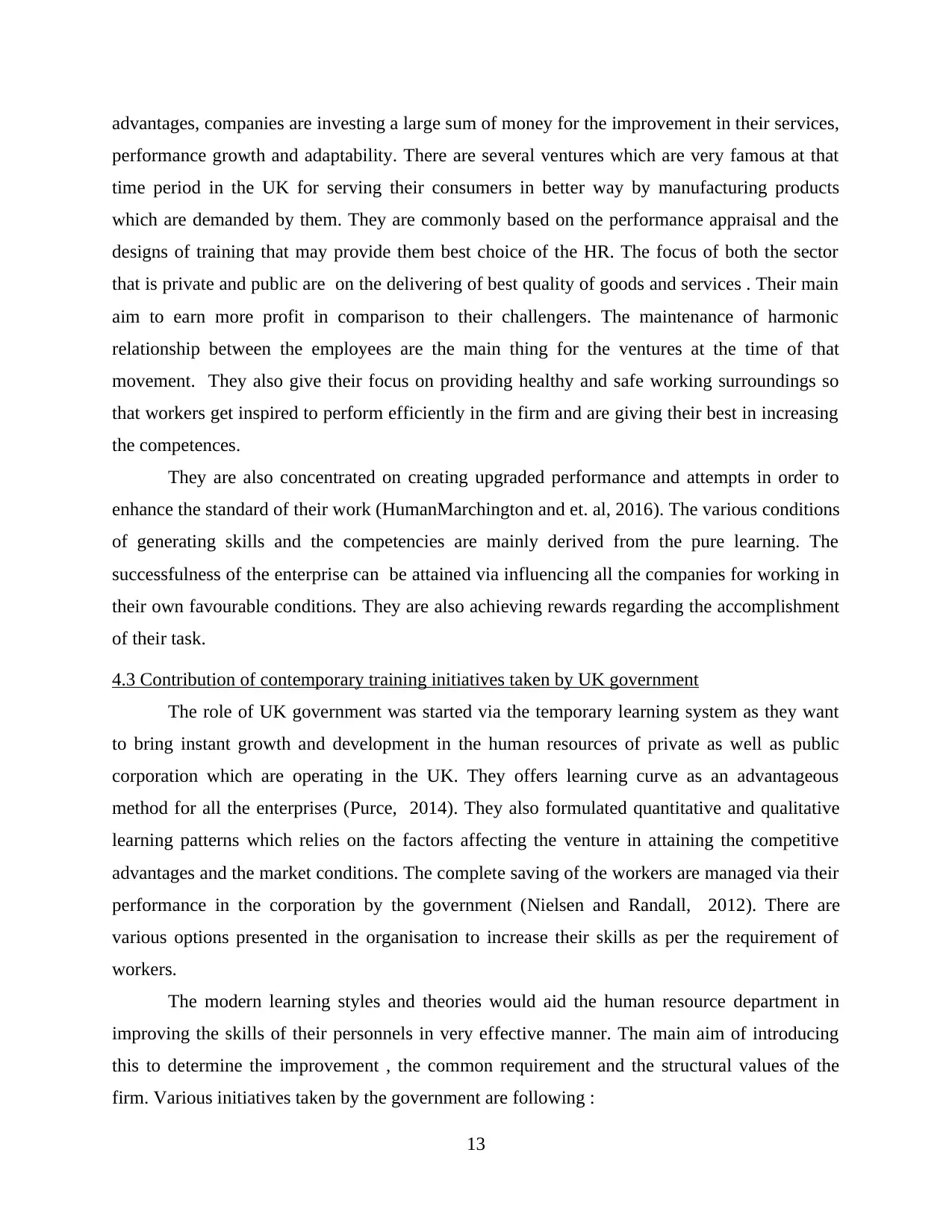
advantages, companies are investing a large sum of money for the improvement in their services,
performance growth and adaptability. There are several ventures which are very famous at that
time period in the UK for serving their consumers in better way by manufacturing products
which are demanded by them. They are commonly based on the performance appraisal and the
designs of training that may provide them best choice of the HR. The focus of both the sector
that is private and public are on the delivering of best quality of goods and services . Their main
aim to earn more profit in comparison to their challengers. The maintenance of harmonic
relationship between the employees are the main thing for the ventures at the time of that
movement. They also give their focus on providing healthy and safe working surroundings so
that workers get inspired to perform efficiently in the firm and are giving their best in increasing
the competences.
They are also concentrated on creating upgraded performance and attempts in order to
enhance the standard of their work (HumanMarchington and et. al, 2016). The various conditions
of generating skills and the competencies are mainly derived from the pure learning. The
successfulness of the enterprise can be attained via influencing all the companies for working in
their own favourable conditions. They are also achieving rewards regarding the accomplishment
of their task.
4.3 Contribution of contemporary training initiatives taken by UK government
The role of UK government was started via the temporary learning system as they want
to bring instant growth and development in the human resources of private as well as public
corporation which are operating in the UK. They offers learning curve as an advantageous
method for all the enterprises (Purce, 2014). They also formulated quantitative and qualitative
learning patterns which relies on the factors affecting the venture in attaining the competitive
advantages and the market conditions. The complete saving of the workers are managed via their
performance in the corporation by the government (Nielsen and Randall, 2012). There are
various options presented in the organisation to increase their skills as per the requirement of
workers.
The modern learning styles and theories would aid the human resource department in
improving the skills of their personnels in very effective manner. The main aim of introducing
this to determine the improvement , the common requirement and the structural values of the
firm. Various initiatives taken by the government are following :
13
performance growth and adaptability. There are several ventures which are very famous at that
time period in the UK for serving their consumers in better way by manufacturing products
which are demanded by them. They are commonly based on the performance appraisal and the
designs of training that may provide them best choice of the HR. The focus of both the sector
that is private and public are on the delivering of best quality of goods and services . Their main
aim to earn more profit in comparison to their challengers. The maintenance of harmonic
relationship between the employees are the main thing for the ventures at the time of that
movement. They also give their focus on providing healthy and safe working surroundings so
that workers get inspired to perform efficiently in the firm and are giving their best in increasing
the competences.
They are also concentrated on creating upgraded performance and attempts in order to
enhance the standard of their work (HumanMarchington and et. al, 2016). The various conditions
of generating skills and the competencies are mainly derived from the pure learning. The
successfulness of the enterprise can be attained via influencing all the companies for working in
their own favourable conditions. They are also achieving rewards regarding the accomplishment
of their task.
4.3 Contribution of contemporary training initiatives taken by UK government
The role of UK government was started via the temporary learning system as they want
to bring instant growth and development in the human resources of private as well as public
corporation which are operating in the UK. They offers learning curve as an advantageous
method for all the enterprises (Purce, 2014). They also formulated quantitative and qualitative
learning patterns which relies on the factors affecting the venture in attaining the competitive
advantages and the market conditions. The complete saving of the workers are managed via their
performance in the corporation by the government (Nielsen and Randall, 2012). There are
various options presented in the organisation to increase their skills as per the requirement of
workers.
The modern learning styles and theories would aid the human resource department in
improving the skills of their personnels in very effective manner. The main aim of introducing
this to determine the improvement , the common requirement and the structural values of the
firm. Various initiatives taken by the government are following :
13
Secure Best Marks with AI Grader
Need help grading? Try our AI Grader for instant feedback on your assignments.
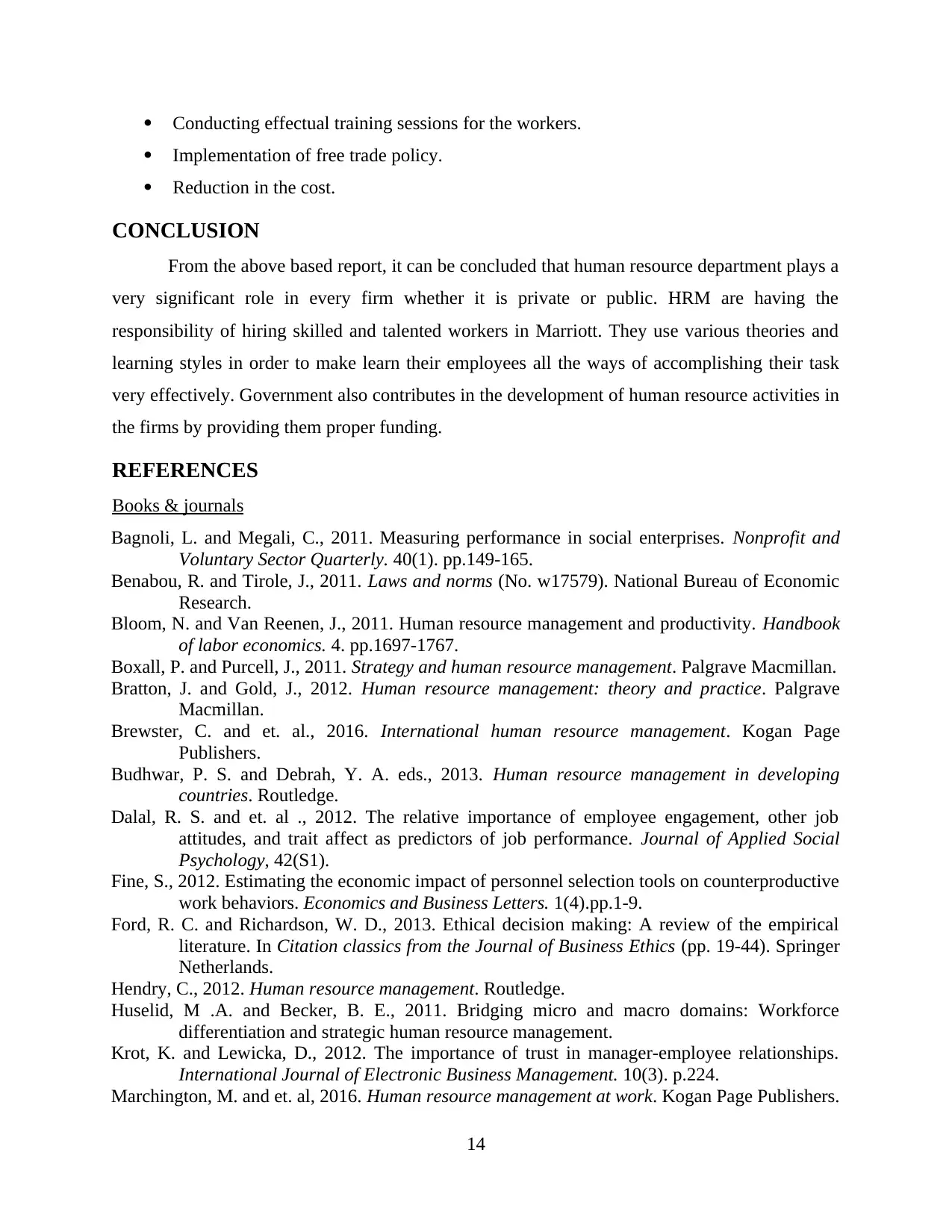
Conducting effectual training sessions for the workers.
Implementation of free trade policy.
Reduction in the cost.
CONCLUSION
From the above based report, it can be concluded that human resource department plays a
very significant role in every firm whether it is private or public. HRM are having the
responsibility of hiring skilled and talented workers in Marriott. They use various theories and
learning styles in order to make learn their employees all the ways of accomplishing their task
very effectively. Government also contributes in the development of human resource activities in
the firms by providing them proper funding.
REFERENCES
Books & journals
Bagnoli, L. and Megali, C., 2011. Measuring performance in social enterprises. Nonprofit and
Voluntary Sector Quarterly. 40(1). pp.149-165.
Benabou, R. and Tirole, J., 2011. Laws and norms (No. w17579). National Bureau of Economic
Research.
Bloom, N. and Van Reenen, J., 2011. Human resource management and productivity. Handbook
of labor economics. 4. pp.1697-1767.
Boxall, P. and Purcell, J., 2011. Strategy and human resource management. Palgrave Macmillan.
Bratton, J. and Gold, J., 2012. Human resource management: theory and practice. Palgrave
Macmillan.
Brewster, C. and et. al., 2016. International human resource management. Kogan Page
Publishers.
Budhwar, P. S. and Debrah, Y. A. eds., 2013. Human resource management in developing
countries. Routledge.
Dalal, R. S. and et. al ., 2012. The relative importance of employee engagement, other job
attitudes, and trait affect as predictors of job performance. Journal of Applied Social
Psychology, 42(S1).
Fine, S., 2012. Estimating the economic impact of personnel selection tools on counterproductive
work behaviors. Economics and Business Letters. 1(4).pp.1-9.
Ford, R. C. and Richardson, W. D., 2013. Ethical decision making: A review of the empirical
literature. In Citation classics from the Journal of Business Ethics (pp. 19-44). Springer
Netherlands.
Hendry, C., 2012. Human resource management. Routledge.
Huselid, M .A. and Becker, B. E., 2011. Bridging micro and macro domains: Workforce
differentiation and strategic human resource management.
Krot, K. and Lewicka, D., 2012. The importance of trust in manager-employee relationships.
International Journal of Electronic Business Management. 10(3). p.224.
Marchington, M. and et. al, 2016. Human resource management at work. Kogan Page Publishers.
14
Implementation of free trade policy.
Reduction in the cost.
CONCLUSION
From the above based report, it can be concluded that human resource department plays a
very significant role in every firm whether it is private or public. HRM are having the
responsibility of hiring skilled and talented workers in Marriott. They use various theories and
learning styles in order to make learn their employees all the ways of accomplishing their task
very effectively. Government also contributes in the development of human resource activities in
the firms by providing them proper funding.
REFERENCES
Books & journals
Bagnoli, L. and Megali, C., 2011. Measuring performance in social enterprises. Nonprofit and
Voluntary Sector Quarterly. 40(1). pp.149-165.
Benabou, R. and Tirole, J., 2011. Laws and norms (No. w17579). National Bureau of Economic
Research.
Bloom, N. and Van Reenen, J., 2011. Human resource management and productivity. Handbook
of labor economics. 4. pp.1697-1767.
Boxall, P. and Purcell, J., 2011. Strategy and human resource management. Palgrave Macmillan.
Bratton, J. and Gold, J., 2012. Human resource management: theory and practice. Palgrave
Macmillan.
Brewster, C. and et. al., 2016. International human resource management. Kogan Page
Publishers.
Budhwar, P. S. and Debrah, Y. A. eds., 2013. Human resource management in developing
countries. Routledge.
Dalal, R. S. and et. al ., 2012. The relative importance of employee engagement, other job
attitudes, and trait affect as predictors of job performance. Journal of Applied Social
Psychology, 42(S1).
Fine, S., 2012. Estimating the economic impact of personnel selection tools on counterproductive
work behaviors. Economics and Business Letters. 1(4).pp.1-9.
Ford, R. C. and Richardson, W. D., 2013. Ethical decision making: A review of the empirical
literature. In Citation classics from the Journal of Business Ethics (pp. 19-44). Springer
Netherlands.
Hendry, C., 2012. Human resource management. Routledge.
Huselid, M .A. and Becker, B. E., 2011. Bridging micro and macro domains: Workforce
differentiation and strategic human resource management.
Krot, K. and Lewicka, D., 2012. The importance of trust in manager-employee relationships.
International Journal of Electronic Business Management. 10(3). p.224.
Marchington, M. and et. al, 2016. Human resource management at work. Kogan Page Publishers.
14
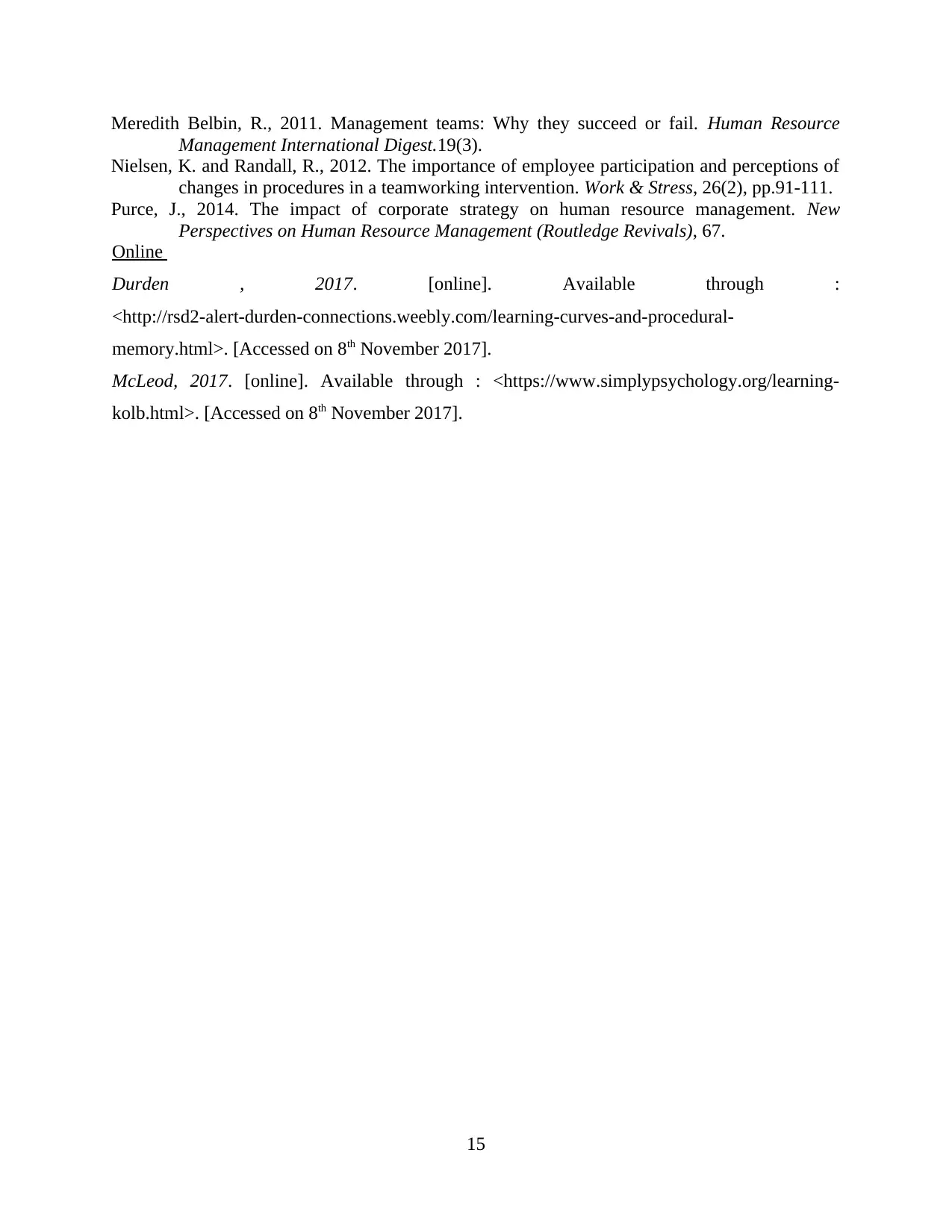
Meredith Belbin, R., 2011. Management teams: Why they succeed or fail. Human Resource
Management International Digest.19(3).
Nielsen, K. and Randall, R., 2012. The importance of employee participation and perceptions of
changes in procedures in a teamworking intervention. Work & Stress, 26(2), pp.91-111.
Purce, J., 2014. The impact of corporate strategy on human resource management. New
Perspectives on Human Resource Management (Routledge Revivals), 67.
Online
Durden , 2017. [online]. Available through :
<http://rsd2-alert-durden-connections.weebly.com/learning-curves-and-procedural-
memory.html>. [Accessed on 8th November 2017].
McLeod, 2017. [online]. Available through : <https://www.simplypsychology.org/learning-
kolb.html>. [Accessed on 8th November 2017].
15
Management International Digest.19(3).
Nielsen, K. and Randall, R., 2012. The importance of employee participation and perceptions of
changes in procedures in a teamworking intervention. Work & Stress, 26(2), pp.91-111.
Purce, J., 2014. The impact of corporate strategy on human resource management. New
Perspectives on Human Resource Management (Routledge Revivals), 67.
Online
Durden , 2017. [online]. Available through :
<http://rsd2-alert-durden-connections.weebly.com/learning-curves-and-procedural-
memory.html>. [Accessed on 8th November 2017].
McLeod, 2017. [online]. Available through : <https://www.simplypsychology.org/learning-
kolb.html>. [Accessed on 8th November 2017].
15
1 out of 18
Related Documents
Your All-in-One AI-Powered Toolkit for Academic Success.
+13062052269
info@desklib.com
Available 24*7 on WhatsApp / Email
![[object Object]](/_next/static/media/star-bottom.7253800d.svg)
Unlock your academic potential
© 2024 | Zucol Services PVT LTD | All rights reserved.





